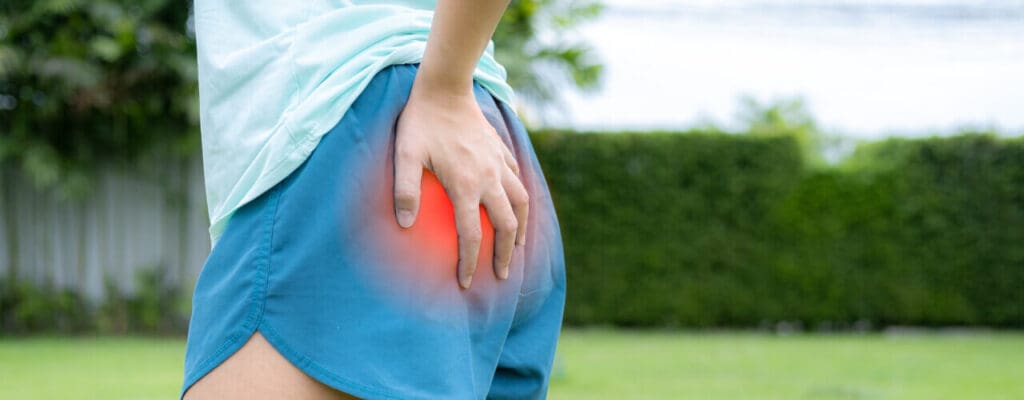How Gluteal Muscles May Lead to Running-Related Injuries

Are you frustrated with persistent pain and/or injuries limiting your running? Have you been told your gluteus are responsible but unsure how or why? Our physical therapists are movement experts at Agility Physical Therapy and can identify your limitations and how they affect your running!
The gluteal muscles play an essential role in everyday activities and are necessary for more vigorous pursuits like running. Unfortunately, the impression that a single muscle is solely responsible for a particular problem creates the potential for more problems. Our team of physical therapists takes a broader view and looks to see how you move as a whole.
At Agility Physical Therapy, our physical therapists will identify all the contributing factors affecting your ability to run and address them individually and as a whole. We understand the importance of getting to the root of your problem and helping you resume the activities you love!
Request an appointment, let our therapists connect the dots, and help you run pain-free again!
Table of Contents
ToggleHow can weakness in one area affect another?
Most people have heard the song about the “foot bone is connected to the leg bone.” Our Agility Physical Therapy physical therapists are experts at identifying how the different body parts influence one another and, more importantly, getting them working together appropriately.
The term kinetic chain describes the interrelated body segments working together. It means how the joints and muscles work together to perform movements and help us function the way we do.
Physical therapists are trained to understand the kinetic chain so completely that we can tell when a weakness in one segment is the actual source of the problem, even though the symptoms (i.e., pain) are felt in a different region.
One of the runners’ most common problem areas is the outer hip region, specifically the gluteal muscle group. These muscles are involved in multiple injuries that runners experience. Understanding that pain is not always located at the actual source of the problem is vital to proper rehabilitation and pain-free running.
Common injuries associated with gluteal weakness
Identifying the problem area is the first step; the final step is coordinating the kinetic chain appropriately so the system works together. Our Agility Physical Therapy team understands the most effective treatment strategies to help you run at your peak performance!
The gluteal muscles can affect injuries throughout the entire length of the leg. The most common injuries associated with gluteal weakness include:
- IT band syndrome: Weakness in gluteal muscles contributes to increased adduction and internal rotation movement of the thigh bone (femur), resulting in runners developing iliotibial band syndrome.
- Patellofemoral knee pain: Multiple studies have linked impaired neuromuscular control and muscle weakness with patellofemoral (kneecap) pain during running.
- Foot ankle problems (i.e., shin splints and ankle sprains): Altered neuromuscular control and weakness of the hip abductor muscles (including the gluteal muscles) are associated with altered movement at the end of the kinetic chain. Increased pronation due to weakness at the hip is related to an increased likelihood of shin splints. At the same time, the lack of hip strength/control is associated with chronic ankle sprains.
In most cases, identifying a single cause of a problem is rare. It is certainly possible with a sudden injury, but most running-related injuries are thought to be chronic. Too often, the symptoms begin as nonspecific and slowly progressive symptoms.
Too often, the individual is misdiagnosed because the source of the pain is not the source of the problem. Fortunately, this is where our physical therapists excel; we’ll get to the root of the problem and provide solutions that work!
What to expect at your physical therapy session
Physical therapy should start immediately following the first sign of pain or injury to ensure the fastest recovery possible. Our Agility Physical Therapy team of physical therapists will thoroughly evaluate the runner to determine the injury’s severity and identify any other weaknesses or limitations that may affect their recovery. We will look at the entire kinetic chain and ensure it functions correctly.
We will focus on pain management and restoring mobility to the injured area. Next, we will progress your strength and dynamic stability exercises designed to restore the function of the kinetic chain and prevent injuries.
As a final step, we will incorporate balance and coordination exercises to stimulate the nervous system and help you return to running without limitations.
Physical therapy in will provide the foundation for pain-free running and reduce future injuries!
Request an appointment at Agility Physical Therapy today!
Our physical therapists are movement experts at Agility Physical Therapy. We will identify all the factors that contribute to your pain/injury, help you resolve them, and restore the proper function of your kinetic chain.
Sources:
- http://www.ochsnerjournal.org/content/19/4/405.abstract
- https://journals.sagepub.com/doi/full/10.1177/2325967120962802
- https://meridian.allenpress.com/jat/article/55/12/1270/444095/Fatigue-Induced-Hip-Abductor-Weakness-and-Changes
- https://www.sciencedirect.com/science/article/abs/pii/S0306987718311575
- https://www.clinbiomech.com/article/S0268-0033(11)00061-1/fulltext
- https://journals.lww.com/acsm-msse/Fulltext/2016/03000/Hip_Abductor_Muscle_Weakness_in_Individuals_with.2.aspx
- https://journals.plos.org/plosone/article?id=10.1371/journal.pone.0247581
- https://pubmed.ncbi.nlm.nih.gov/29705166/
